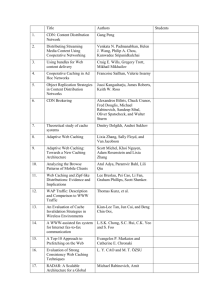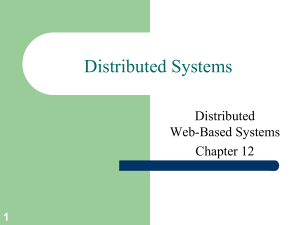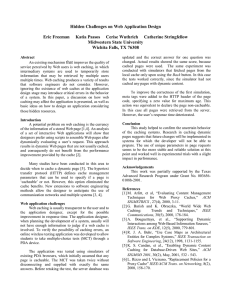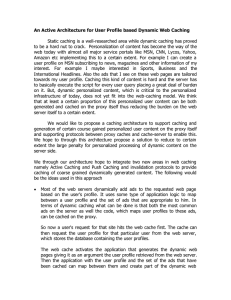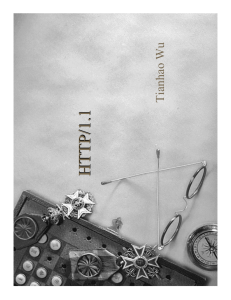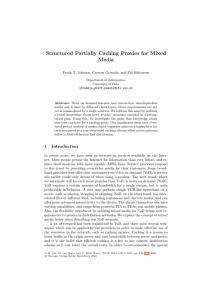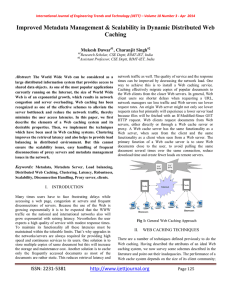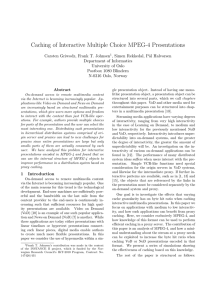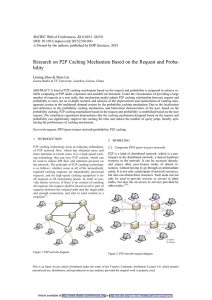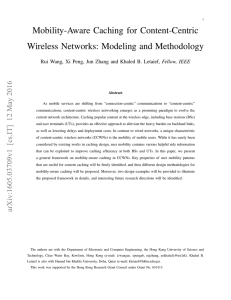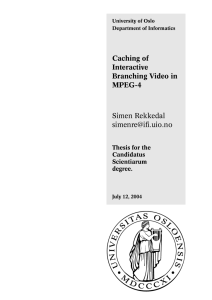Structured Partially Caching Proxies for Mixed Media Frank T. Johnsen, Carsten Griwodz,
advertisement
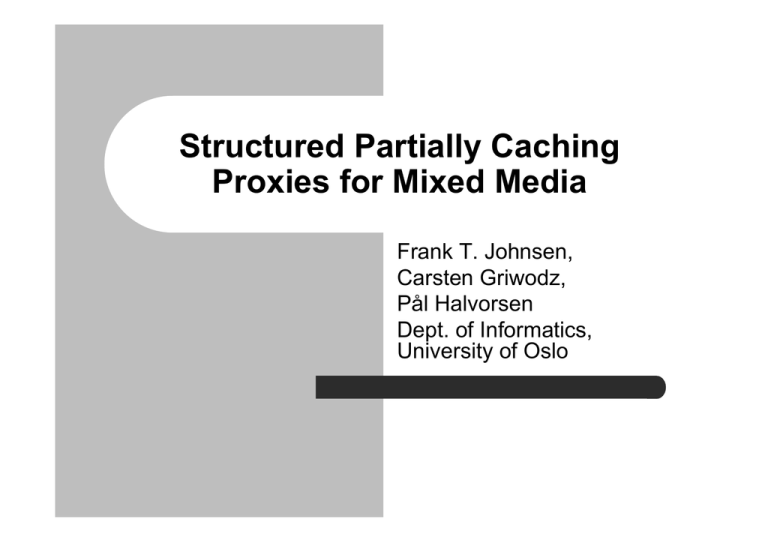
Structured Partially Caching Proxies for Mixed Media Frank T. Johnsen, Carsten Griwodz, Pål Halvorsen Dept. of Informatics, University of Oslo Mixed media data An object may be any multimedia data type, be it continuous (video, audio) or discrete (text, pictures). How the client should use the objects is described by metadata - a presentation plan. Objects or parts of them can be reused. Proxies for NoD We want to accommodate the needs of mixed media news on demand (NoD) data. Characteristics of mixed media NoD: – – – – – User interaction. Different client types. A news item may consist of several different objects. The relationship between objects is described by a presentation plan. Some content is reused. So far not addressed by a single solution. Partial caching Hypothesis: – A proxy utilizing knowledge about structure will be more efficient (exhibit a higher byte hit ratio) than a proxy that does not. We employ a means of partial caching to accommodate the needs of mixed media applications. Different types of partial caching: – – Time domain (Rexford et al 1999) Quality domain (Rejaie et al 2000, Schojer et al 2003) We introduce structured partial caching. Caching with structure There are two kinds of structure: – Structure between objects For example, objects are part of the same presentation plan. – Structure within objects Described by metadata; for example reuse of parts of a video. Format specific; for example layered video and progressive jpeg. This should also be described by the metadata. We have looked into applying quality partial caching in our scenario utilizing knowledge of structure within objects. Structured caching example The news item A consists of two media objects. This is external structure. Media objects may be layered as shown. This is internal structure. All structure is described by metadata in the presentation plan, thus allowing the proxy to cache data consistently regardless of format. Structured caching example News item B reuses the media objects from A in a new presentation. This adds further internal structure to the media objects. The proxy tracks this and collects access statistics. The shaded area indicates that presentation A has been cached for low quality, i.e., lower layers only. Structured caching example Time passes, A is no longer popular. B is still being requested, leading to caching of only the parts in use. If higher quality is requested later, further layers will be cached. Simulations SERVER − infinite disk space Other assumptions: – − zero delay − unlimited bandwidth PROXY − finite disk space − zero delay − unlimited bandwidth CLIENT – – The proxy has the presentation plan. The presentation plans and the media objects all have unique IDs. Client requests follow the Multi-selection Zipf distribution (from Clustered Multimedia NoD: Popularity-Based Article Prefetching and Placement, Kim et al.). Simulation results / quality 0.9 0.8 byte hit ratio 0.7 0.6 100 0.5 90-10 0.4 50-50 0.3 0 0.2 0.1 0 full object structured partial Simulation results / cache size 0.9 0.8 byte hit ratio 0.7 0.6 small 0.5 medium 0.4 large 0.3 0.2 0.1 0 full object structured partial Simulation results / adm. policy 0.9 0.8 byte hit ratio 0.7 0.6 small 0.5 medium 0.4 large 0.3 0.2 0.1 0 full object full object 3 day admission structured partial structured partial 3 day admission Is structured partial caching smart? Conclusions for mixed media NoD scenario: – – – Gains when utilizing knowledge of structure. More CPU intensive than a scheme not considering structure (3.5-5 times more). CPU is not a bottleneck. Future work/open issues Investigate additional gains possible by proxy cooperation. Refined interactivity patterns (Kim et al a bit coarse grained). Thank you for your attention! Questions?
